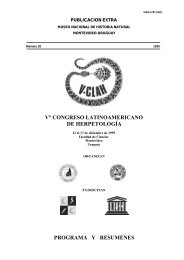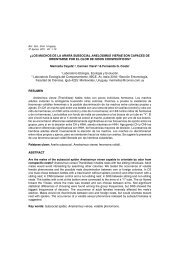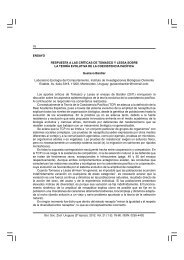Primer Congreso Uruguayo de Zoología - Sociedad Zoológica del ...
Primer Congreso Uruguayo de Zoología - Sociedad Zoológica del ...
Primer Congreso Uruguayo de Zoología - Sociedad Zoológica del ...
Create successful ePaper yourself
Turn your PDF publications into a flip-book with our unique Google optimized e-Paper software.
FIRST NEOGENE TYPOTHERIA (MAMMALIA, NOTOUNGULATA, HEGETOTHERIIDAE) OFURUGUAYBostelmann E. & Rin<strong>de</strong>rknecht A.Museo Nacional <strong>de</strong> Historia Natural. Montevi<strong>de</strong>o, Uruguay. ebostel@yahoo.comTypotheria constitutes one of the two subor<strong>de</strong>rs of the extinct Notoungulata, the most diverse group of native SouthAmerican ungulates ever recor<strong>de</strong>d. So far, the occurrence of typotheres in Uruguay has only been registered inPaleogene sediments of the Fray Bentos Formation (late Oligocene, Deseadan SALMA). In this contribution we<strong>de</strong>scribe remains of a Neogene hegetotheriine typothere (family Hegetotheriidae, subfamily "Hegetotheriinae"),collected in the "Kiyú lithofacies" of the Camacho Formation, Playa Arazatí, San José Department. The material ishoused at the Museo Nacional <strong>de</strong> Historia Natural, Montevi<strong>de</strong>o. MNHN 2681 is a partially complete mandible withthe left hemimandible preserving most of the horizontal ramus, the alveoli of the i1 - p2, the p3 - m3 <strong>de</strong>ntal series,and part of the ascending ramus. The right hemimandible is broken at the level of the p4, retaining only the i1, i2, p2and p3. The study of the <strong>de</strong>ntition confirmed the absence of p1 and the lack of a post-canine diastema. Generaldimensions in conjunction with: 1) presence of thick cementum, <strong>de</strong>ep sulcus, and angular bor<strong>de</strong>rs on the buccal facesof lower molars; 2) a reduced p2; 3) convex lingual faces and narrow distal faces of lower molars; and 4) a bilobedm3, allocate this remains to Hemihegetotherium and specifically to H. achataleptum, the type species of the genus.Hemihegetotherium has been <strong>de</strong>scribed from Miocene sediments (middle to late Miocene Laventan to HuayquerianSALMAs) of Bolivia, Argentina, and probably Venezuela. A bivariate plot on m1 length vs. width approximate MNHN2681 to specimens collected in southeastern localities of La Pampa Province, Argentina. The presence of H.achataleptum in Arazatí provi<strong>de</strong>s a new taxa of typical Huayquerian affinities to the "Kiyú lithofacies" - vertebratefauna, an apparent contradiction with recent isotopic dates that suggest an earlier (Burdigalian, early Miocene) agefor these <strong>de</strong>posits.OLIGOCENE GLYPTODONTIDAE (MAMMALIA, CINGULATA) FROM THE FRAY BENTOSFORMATION OF URUGUAYBostelmann E. 1 , Rin<strong>de</strong>rknecht A. 1 , Ciancio M.R. 2 , Toriño, P. 3 & Perea D. 31 Museo Nacional <strong>de</strong> Historia Natural. Montevi<strong>de</strong>o, Uruguay. 2 CONICET. Departamento <strong>de</strong> Paleontología <strong>de</strong> Vertebrados, Museo <strong>de</strong> LaPlata, B1900. La Plata, Argentina. 3 Departamento <strong>de</strong> Evolución <strong>de</strong> Cuencas, Facultad <strong>de</strong> Ciencias. Montevi<strong>de</strong>o, Uruguay.ebostel@yahoo.com.Excluding the enigmatic Glyptatelinae, Paleogene glyptodontids are extremely rare in the fossil record. In<strong>de</strong>ed, theonly unquestionable published remains belong to isolated osteo<strong>de</strong>rms assigned to an uni<strong>de</strong>ntifiedPropalaehoplophorinae from the late Oligocene El Pajarito locality of Chubut Province, Argentina. Nevertheless, thefirst mention of Oligocene glyptodontids was ma<strong>de</strong> by A. Castellanos based on two isolated osteo<strong>de</strong>rms collected inthe Barranca <strong>de</strong> Los Loros, at the Colonia Department, southwestern Uruguay. The paleontology collection of theMuseo Municipal “Prof. Lucas Roselli” (MLR) houses remains of an unpublished “non glyptateline” glyptodontidlabeled as “Bertawileria” sp., here <strong>de</strong>scribed in <strong>de</strong>tail. MRL 702 inclu<strong>de</strong>s ten almost complete osteo<strong>de</strong>rms exhumedfrom the Fray Bentos Formation mudstones, in the “Barrancas <strong>de</strong> la Zona Franca <strong>de</strong>l Puerto <strong>de</strong> Nueva Palmira”, a nowdisappeared locality supplanted by the facilities of the international harbor. The remains represent different regionsof the carapace; four partial osteo<strong>de</strong>rms from the dorso-lateral area; three lateral rectangular ones; two from thelateral bor<strong>de</strong>r; and one anterior semi-mobile piece. All of them exhibit a punctuated, flat and smooth externalsurface, with rugose extensions on the contact zone. Ornamentation consists in the typical “rossetta”-pattern with analmost circular big central figure surroun<strong>de</strong>d by numerous small prismatic peripheral figures, all <strong>de</strong>limited by shallownarrow sulcus with small foramina in their intersections. In accordance to this morphology we tentatively assign theremains to Propalaehoplophorinae in<strong>de</strong>t. MLR 701 consists in three postcranial remains associated to 702: 1) theproximal portion of a right tibia with the articular surfaces for the femur; 2) a possible carpal bone, and 3) onefragmented articular bone of uncertain position. Our investigations shows that the past diversity of OligoceneCingulata in Uruguay, while scant, is quite relevant to improve a better knowledge on the early diversity of SouthAmerican fossil cingulates.74 <strong>Primer</strong> <strong>Congreso</strong> <strong>Uruguayo</strong> <strong>de</strong> <strong>Zoología</strong>







